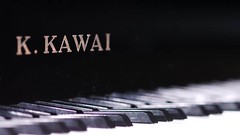One of the most critical functions on a camera is the focus mechanism and user interface.
For static subjects or one shot action shots, I like to be able to lock focus, recompose (or wait for the action – eg a bee to land on my flower) and take my fingers off any button such as shutter button so i don’t accidentally press it and then maybe even 10 minutes later, take the shot knowing my focus is pre-locked – for this I use MF mode with AF lock.
All current dSLRs support various autofocus (AF) and manual focus (MF) modes with a choice of AF sensor modes such as automatically use any of the sensor points or allowing you to use just one of them so you know what you will be focusing on.
Furthermore, the latest cameras have Live Preview with magnification so that precise manual manual focus is now possible – most dSLRs no longer have the microprism/split image focus assist devices in the viewfinder focusing screens to assist manual focus, which made manual focus more difficult.
I decided to write this after a friend bought a Nikon D90 and asked me to show him how to use it and its interface is quite a lot different to my Olympus E510 or my Canon 1DMIII and for the life of me I couldn’t work out how to change the AF points, etc without downloading the camera manual – which I have now done.
The Nikon comments on these blogs are from the manual, not my actual testing. I have used a LOT of cameras and for an entry level camera, the user interface should be as intuitive as possible. Obviously, for a pro camera, the interface needs to be functional rather than intuitive as they are using it every day so they can master its quirks and memorise them. Thus a pro camera is NOT really the best camera for an occasional photographer as they will be confused with its complexity.
This first blog on lens focus I am going to compare how easy it is to use AF when you are in non-live-preview MF mode.
This functionality is important for at least two reasons:
- you may have left the camera in MF mode and suddenly you want to capture a shot in AF and you forgot you are in MF mode
- you may wish to use MF to get close to focus and then the AF mechanism will be much faster in acquiring focus lock
First, the Olympus E510:
- all Olympus ZD lens have full time MF over-ride so they do not need a MF switch on the lens to confuse you or forget that you have it switched on – likewise the IS is in the body – you don’t have to always be checking to see if you have it switched on as is the case on Canon & Nikon lenses – if they have this feature
- there is a simple AF mode button on the rear which allows you to select 5 focus modes using the dial – my preference for non-action work is to leave it in MF mode, although if you want to totally inactivate MF, you could use S-AF mode and you wont accidentally move the lens focus ring, or if you want AF to automatically override your MF you can use C-AF+MF and then you can get near to focus manually if you wish then quickly snap into AF.
- why do I set it to MF by default?
- assuming you are using the default AFL/AEL settings on the menu: S:1, C:2,M:3, then when using the MF mode, you will have full time manual focus which is unaffected by half-pressing the shutter speed, but if you need AF, all you need do is press the AEL/AFL button on the rear and you will get AF lock but still able to MF if need be – now that is perfect for 90% of my photography as I can AFL on my subject without having to keep my finger half-pressed on the shutter button or on the camera at all, so I can allow self-timer and mirror lockup to minimise vibrations if need be, recompose the take the shot
- if you are giving the camera to someone else to use, just set AF mode to S-AF and they can have their familiar half-press shutter to lock AF functionality
Now for the Canon 1DMIII pro camera:
- unlike Olympus, Canon EF AF lenses have a AF/MF switch on the lens which inactivates the cameras AF mechanism, so you have to remember to reset that to AF if you want AF. Of course, most EF lenses now have fulltime MF over-ride so you can leave the lens in AF and still use MF, BUT unless you disable half-press shutter AF lock, the camera’s AF will over-ride your MF
- the camera has a AF-DRIVE button which is used to select between AI-SERVO (eg. C-AF) and ONE-SHOT AF (eg. S-AF) modes via the dial
- THUS, to enable this same MF style mode I use on the Olympus, you must set C.FnIV-1 to item 3 so that AF lock is via the AF-ON button on the rear of the camera and NOT the shutter button
- unfortunately, if you happen to give the camera to someone else, there is no quick way of re-instating the half-press shutter button AF lock functionality they are used to without going through the menus and changing this setting, or loading a different camera preset settings mode
Now for the Nikon D90:
- the situation is more complicated as Nikkor AF-S lenses have a AF/MF lens switch which will disable the camera’s AF, while if you use older AF lenses you must use a AF/MF switch on the front left of the camera body otherwise you could risk damaging the focus system on the lens
- the AF button on bottom right rear allows selection of either:
- AF-A which automatically decides to use either C-AF or S-AF mode – not sure why you would want the camera to decide this for you!
- AF-S – single AF = One Shot AF = S-AF mode
- AF-C – continuous AF = AI-SERVO – C-AF mode
- thus to get my method of MF with quick AF override, presumably you must either:
- have an AF-S lens in AF mode which allows full time MF and set menu item f4 assign AE-L/AF-L button (p.200 of manual) to AF-ON which will disable shutter button to AF
- unfortunately, as with the Canon, there is no simple way to quickly re-enable the shutter button AF lock functionality if you hand your camera to someone else to use – you must go through the menu system
- set the lens or camera AF/MF switch to MF then reset it to AF when you want AF to work, then lock AF via shutter button or holding down the AE-L/AF-L button
- I guess this is how most Nikon users will use it, but what happens if they use a AF lens and forget it is in AF mode and start using the MF ring to focus – dead lens?
- unfortunately, there is NO easy way that you can attain AF lock and keep it without your hands on the camera, and thus for critical work with self timer and mirror up to reduce vibrations, you would need to resort to MF mode on the lens or the above menu setting for AF-ON
- the Olympus has the focus confirmation working at all times with Four Third system lenses, as long as the viewfinder data is activated and has not timed out (a quick half press of shutter will bring it back to life). Critically important is the fact you don’t need to press a AF lock button to get focus confirmation as otherwise on this camera you would get AF lock attempt over-riding your MF.
- the Canon 1DMIII has focus confirmation ONLY if AF lock button is pressed and unless you have the lens in MF switch mode, the AF lock will over-ride your MF which is NOT what we want!
- there is NO mention of focus confirmation in the user manual for the Nikon D90
Finally, manual focus confirmation indication:
Summary:
In my opinion, the Olympus has the easiest mechanism by far for combining C-AF with MF and switching back into traditional shutter button controlled AF lock modes, .
As 90% of most people’s photography is relatively static subjects this should be a factor to consider, and for this work, I strongly suggest you only use one AF point so you know what is going to be in focus and not what the camera thinks should be in focus – thus having only 3 AF points is NOT an issue – I only use the centre one anyway.
Of course, for action work, the Olympus E510 is let down by its 3fps burst rate and only 3 AF points, so you would be better off getting the Olympus E3 or the forth-coming “tweener” Olympus dSLR in March 2009.
If you need low noise at high ISO for action work then the pro Canon 1DMIII or the Nikon D700 or D300 would be better options assuming you will be using them frequently enough to understand their complexities.
Of course, the Nikon D90 has many other good features (4.5fps, 11point AF for action shots, video mode, hi-res LCD screen, CA correction, wireless TTL flash) that the much older Olympus E510 doesn’t have (but the Nikon still doesn’t have the in-built image stabilisation and in my view, the E510’s simplicity of use and excellent lenses are important) – dpreview.com have just posted a review of the Nikon D90 here . I expect the Olympus ‘tweener’ dSLR will match the D90’s features and include swivel LCD and image stabilisation built-in and allow use of the best cropped sensor lenses in the business.
NB. I’m very happy for Nikon users to correct me if I have made errors on the functionality of the Nikon.










